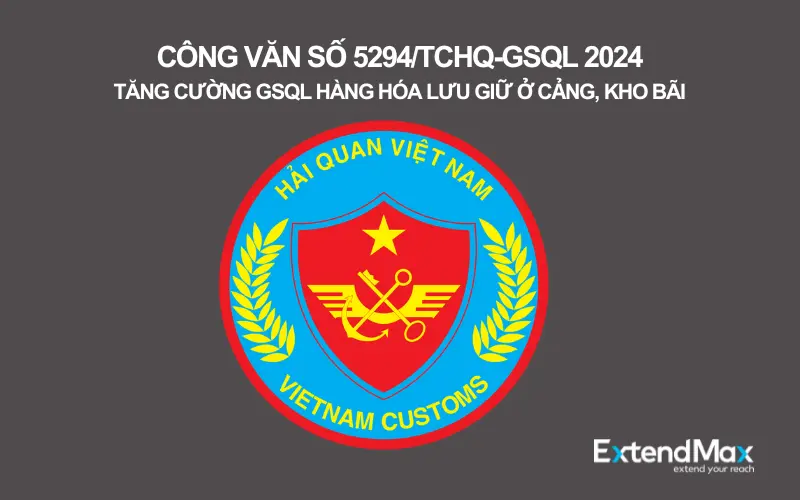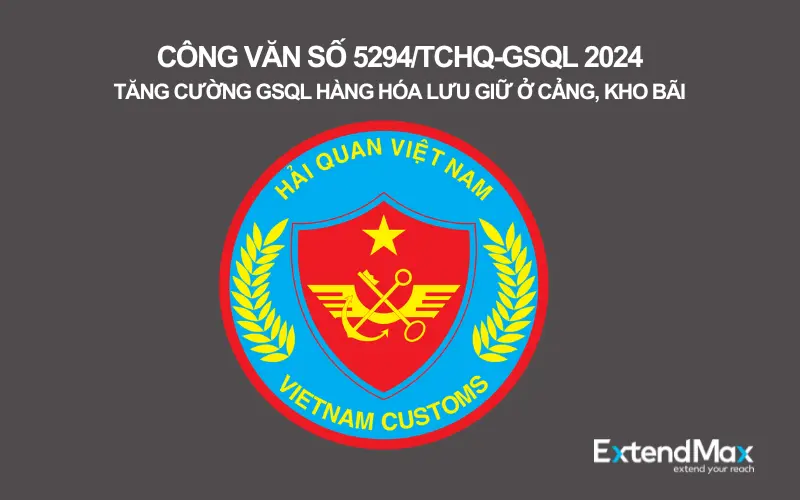EXTENDMAX – On October 30, 2024, the General Department of Customs issued Official Dispatch No. 5294/TCHQ-GSQL on strengthening the management and customs supervision of goods entering, stored at, and exiting ports, warehouses, and storage yards. According to the content of Official Dispatch 5294/TCHQ-GSQL, the General Department of Customs does not allow the modification of recipient information in cases where the goods are prohibited from import, temporarily suspended from import, or require an import permit from a specialized agency, but the importer does not have the appropriate permit. This change in regulations underscores the increasingly vital role of professional consulting companies like ExtendMax.
If goods are imported to the port without the necessary specialized import permit, you may face the following risks:
-
Delays in customs clearance due to the need to obtain an import permit, resulting in significant storage fees.
-
In some cases, even if the importing company qualifies for the permit, it may need to return or destroy the goods.
To ensure a smooth and timely import process, contact the experts at ExtendMax for consultancy on product conformity certification, civil cryptography permits, and assistance in evaluating the necessary import documents, estimating permit costs, and guiding the import process.

Please refer to the content of Official Dispatch No. 5294/TCHQ-GSQL below:
| MINISTRY OF FINANCE | SOCIALIST REPUBLIC OF VIETNAM |
| No: 5294/TCHQ-GSQL | Hanoi, October 30, 2024 |
To: Provincial and City Customs Departments.
To strengthen the management and customs supervision of exported and imported goods entering, stored at, and exiting port, warehouse, and yard areas to prevent and combat smuggling and commercial fraud; based on the 2014 Customs Law, Decree No. 08/2015/ND-CP dated January 21, 2015, as amended and supplemented by Decree No. 59/2018/ND-CP dated April 20, 2018, Decree No. 29/2018/ND-CP dated March 5, 2018, and related legal documents, the General Department of Customs requires Customs Departments of provinces and cities to implement the following:
I. Strengthening the management and supervision of goods entering and exiting port, warehouse, and yard areas through the VASSCM System.
1. Direct relevant Customs Sub-Departments to require port, warehouse, and yard business enterprises (BEs) to update complete and accurate information on goods entering (getin) port, warehouse, and yard areas, including any discrepancies, and exiting (getout) such areas, and send this information to the VASSCM system as stipulated in Clauses 31 and 32, Article 1 of Circular No. 39/2018/TT-BTC dated April 20, 2018, of the Ministry of Finance, with the following notes:
a) Update getin information (including the description and name of goods, if applicable) and send it to the VASSCM system immediately after the goods are unloaded at the port, warehouse, or yard.
b) Fully and accurately update getout information and send it to the VASSCM system no later than 15 minutes after the goods are removed from the port, warehouse, or yard, including details on the "vehicle number/license plate of the transport vehicle" carrying the goods out of the port, warehouse, or yard (including cases where goods are transported in multiple vehicles at different times and where multiple declarations share one container).
If a port, warehouse, or yard BE does not comply with Article 41 of the Customs Law and related guidelines (e.g., unloading goods at incorrect ports as indicated on the cargo manifest, waybill; permitting goods to leave the port, warehouse, or yard without receiving information confirming that the goods are eligible to exit the supervised area; failing to provide information to customs during monitoring and inspection processes), administrative penalties will be applied under Decree No. 128/2020/ND-CP dated October 19, 2020.
In cases where an enterprise is found to be involved in smuggling or unauthorized cross-border transport of goods, coordinate with relevant authorities for investigation and handling according to the law.
2. Relevant Customs Sub-Departments should direct customs officers to perform daily supervision based on the list of containers scheduled for unloading available on the National Single Window Portal, related systems (VNACCS/VCIS, E-CUSTOMS), and other information sources to check, review, and compare getin and getout information updated by port, warehouse, and yard BEs in the VASSCM system for completeness, accuracy, and timeliness.
3. If, after review, goods that have been confirmed eligible for release from the supervised area and have already exited the port, warehouse, or yard are found, but the declaration/document information has not been confirmed in the system, proceed as follows:
a) Customs Sub-Department where goods are stored:
a.1) Collaborate with the port, warehouse, and yard BE to verify when (date, month, year) the goods were actually entered or exited; which eligible declaration/document corresponds to the actual release of the goods; and clarify the reason (system issue, BE error, declarant error, customs officer error, or other reasons) for the unconfirmed declaration in the system.
a.2) After verification, if it is determined that the declarant, BE, and customs officer have fulfilled their responsibilities under Article 41 of the Customs Law, Clauses 31 and 32 of Article 1 of Circular No. 39/2018/TT-BTC, and the actual shipment has been confirmed to exit the port, warehouse, or yard with the declaration/document, update or request the BE to update the system accordingly.
Port, warehouse, and yard BEs must store information and documents proving that the goods have completed the process for release from customs supervision (qualified for exiting the supervised area) provided by the declarant and present them to investigating, inspection, and audit authorities upon request. Additionally, they must compile and report updates of goods information (confirmed as qualified for exiting the supervised area) to the Customs Sub-Department for monitoring, review, and risk-based verification.
a.3) Based on the results of the review and verification, determine the responsibilities of the parties involved (customs declarant; port, warehouse, and yard business enterprise (BE); customs officer) for correction or handling of violations (if any) according to the provisions of the law.
b) Customs Sub-Department where the declaration is registered:
b.1) Regularly review unconfirmed declarations in the system. If a customs declaration falls under the category requiring amendment (due to incorrect/missing information) or cancellation, promptly notify the enterprise to carry out the amendment, supplement, or cancellation procedures in accordance with regulations.
b.2) Coordinate with the border gate Customs Sub-Department to provide relevant information regarding the implementation of customs procedures as requested by the border gate Customs Sub-Department, serving as a basis for determining whether the goods are eligible for release from the supervised area and for the border gate Customs Sub-Department to have information for verification with the port BE regarding the actual export or import of goods according to which declaration or document.
4. Provincial and city Customs Departments should regularly review/inspect the internal procedures involving assigned officers to assess the management and supervision of goods entering and exiting port, warehouse, and yard areas to ensure compliance with regulations. If violations are found, follow the guidance in Decision No. 779/QD-TCHQ dated April 12, 2023, and other related regulations to consider appropriate actions.
In cases where Customs Sub-Departments responsible for declaration registration or goods storage are negligent or delay handling, resulting in goods being released without confirmation in the system, the head of the involved Sub-Department must report and explain to the leadership of the provincial or city Customs Department; the director of the Customs Department must report and explain to the General Department leadership.
II. Inspection, Supervision, and Handling of Goods Exceeding the Time Limit for Customs Procedures
1. For goods stored at ports, warehouses, and yards from 30 to 90 days:
a) For imported goods that have not completed customs procedures, the Head of the Customs Sub-Department where the goods are stored should base their risk analysis and assessment on cargo manifests (Emanifest) and other sources of information (if available) and apply x-ray scanning or other appropriate control measures for shipments showing signs of violations or high risk; and update the scanning results in the system (if applicable).
b) When a company registers a declaration, the Head of the Customs Sub-Department where the declaration is registered should, based on the system's channeling results, customs documentation, signs of violations, risk indicators, and scanning results (if any), decide on actual inspection of the goods, handle violations (if any), and process customs procedures as per regulations.
2. For goods stored at ports, warehouses, and yards for over 90 days:
On the 15th of each month, the Customs Sub-Department where the goods are stored must compile, review, and query data on goods stored at ports, warehouses, and yards for over 90 days without customs procedures, comparing these with the data monitored by port, warehouse, and yard business enterprises (BEs) to identify goods stored over 90 days and leftover goods. If no one claims the goods after 90 days, the Customs Sub-Department must issue a notice to find the owner as per Article 8 of Circular No. 203/2014/TT-BTC dated December 22, 2014, and proceed as follows:
a) If someone claims the goods and registers a declaration within the notification period, the Customs Sub-Department equipped with an x-ray machine should scan and update the scanning results in the system (except for cases where scanning has already been conducted or goods are unsuitable for scanning as per Decision No. 2056/QD-TCHQ dated August 29, 2024). If no scanning equipment is available and goods need to be transported to an off-site inspection location, the Customs Sub-Department should transfer the goods (including unscanned goods information) to the Customs Sub-Department where the declaration is registered for physical inspection, violation tracking (if any), and continued customs procedure processing.
b) If the notification period to find the owner expires and no one claims the goods, the Customs Sub-Department must report to the Director of the Provincial/City Customs Department for a decision to establish a Board to handle leftover goods and conduct an inventory and classification as per Article 12 of Circular No. 203/2014/TT-BTC dated December 22, 2014. After inventory and classification:
b.1) If identified as prohibited imports, temporarily suspended imports; waste not meeting environmental conditions and standards, goods without permits, or goods not eligible for import (e.g., used consumer goods; used components and parts in the prohibited list; used materials, vehicles, machinery, and equipment), the Customs Sub-Department where the goods are stored must identify the violating entity, the nature of the violation, record administrative violations, and decide on administrative sanctions as per the Customs Law, Law on Handling Administrative Violations, Decree No. 128/2020/ND-CP dated October 19, 2020, and related legal documents. If criminal signs are detected, the customs authority will investigate and handle as per their jurisdiction.
b.2) Handling re-export of goods exceeding the time limit for customs procedures:
For shipments that exceed the time limit for customs procedures and are not under investigation by competent authorities, based on a request from the carrier or the owner, in accordance with Clause 4, Article 48 of Decree No. 08/2015/ND-CP dated January 21, 2015 (amended and supplemented by Decree No. 59/2018/ND-CP dated April 20, 2018), and Articles 95, 96, and 52b of Circular No. 38/2015/TT-BTC dated March 25, 2015, as amended and supplemented by Circular No. 39/2018/TT-BTC dated April 20, 2018, the Head of the Customs Sub-Department where the goods are stored decides on physical inspection if signs of violation are detected, considers processing re-export procedures, and supervises until the entire shipment is officially exported from Vietnam's territory at the entry port; there is no requirement to re-export to the original exporting country.
b.3) Handling the destruction of goods exceeding the time limit for customs procedures:
Based on the Environmental Protection Law, Law on Handling Administrative Violations, Decree No. 29/2018/ND-CP dated March 5, 2018, Circular No. 203/2014/TT-BTC dated December 22, 2014, Circular No. 57/2018/TT-BTC dated July 5, 2018, of the Ministry of Finance, and related regulations, the Customs Sub-Department where the goods are stored must review and compare information with port, warehouse, and yard business enterprises (BEs) and transporters to identify goods subject to destruction and proceed as follows:
b.3.1) Based on the document from the competent authority or the destruction request document from the transporter, accompanied by documents proving the legal status of the destruction unit, the Customs Sub-Department where the goods are stored must check and verify the documents to confirm: the destruction unit meets the required competency, is licensed by the competent authority for destruction; the volume of goods matches the capacity, timeline, and destruction plan; the goods align with the scope of processing of the company. The Customs Sub-Department then compiles and submits a destruction plan to the Provincial/City Customs Department or the Chair of the Council for Handling Leftover Goods for approval. This plan must detail the list of goods, shipping company names, destruction unit, expected timeline, destruction plan, and the responsibilities of the Destruction Handling Council.
b.3.2) Approval for destruction plans is not granted for units that do not meet the legal environmental requirements or have previously been penalized for failing to follow approved destruction plans or for diverting goods marked for destruction into domestic consumption or other purposes.
b.3.3) Strictly supervise the goods during transportation from the port, warehouse, or yard to the destruction site; from the unsealing and entry of goods into destruction until completion, ensuring that the goods marked for destruction do not enter the domestic market.
Goods destruction supervision is conducted through direct oversight or by technical means.
b.3.4) The process of transferring goods to the destruction company and the actual destruction must be documented with confirmation from all involved parties, and images and records should be kept in the Destruction Handling File. The results of the destruction should be updated according to Appendix 2 or Appendix 3 attached to this document.
c) After inventory and classification, the Council for Handling Leftover Goods should create a file and report to the Director of the Customs Department for a decision on state ownership of leftover goods and the handling plan as stipulated in Decree No. 29/2018/ND-CP dated March 5, 2018; Circular No. 203/2014/TT-BTC dated December 22, 2014, Circular No. 57/2018/TT-BTC dated July 5, 2018, of the Ministry of Finance for execution.
d) Handling arising costs:
Based on Article 12 of Circular No. 57/2018/TT-BTC dated July 5, 2018, of the Ministry of Finance, any costs incurred before the competent authority's decision on state ownership of the property (including inventory, classification costs; inspection costs to identify violations, remaining asset value, etc.) must be covered by port, warehouse, yard business enterprises; agencies, or related shipping companies.
3. Modifying consignee information on the Cargo Manifest (Emanifest) for shipments stored at ports, warehouses, and yards:
a) Responsibilities of the Customs Sub-Department handling the entry and exit of vehicles:
a.1) Within 5 days of receiving the request letter accompanied by supporting documents for modifying Emanifest information submitted by the shipping company/carrier or their representative, the Customs Sub-Department handling the entry and exit of vehicles must send a request letter including the shipment details for the proposed modification of consignee information to the Customs Sub-Department where the goods are stored to conduct a physical inspection of the goods as a basis for considering and deciding on the modification of consignee information on the Emanifest and updating the system.
a.2) Modifications of consignee information are not permitted for:
- Goods inspected and identified as belonging to the list of prohibited or temporarily suspended imports;
- Goods requiring an import permit from a specialized management agency when the consignee does not possess such a permit;
- Used machinery and equipment, scrap where the importer does not meet the legal import requirements as per specialized regulations;
- Goods that have been registered for customs declaration but not yet had the declaration cancelled by customs authorities as required;
- Goods under investigation or verification by relevant authorities.
a.3) If the document review and physical inspection results confirm that the goods qualify for modification but the Customs Sub-Department handling the vehicle procedures cannot update the modification in the system (due to historical data on goods stored at the port, warehouse, or yard having been moved to a dedicated storage area within the Customs Data Center), a report must be sent to the Provincial/City Customs Department, which will request the Customs IT and Statistics Department's assistance in updating the modification.
b) Responsibilities of the Customs Sub-Department where the goods are stored:
Within 5 days of completing the physical inspection, if it is determined that the goods do not fall under the cases specified in point a.2 of section 3, part II of this document, a notification must be sent to the Customs Sub-Department handling the entry and exit of vehicles to proceed with the relevant procedures as stipulated.
4. Area for Storing Goods Left Over 90 Days:
Port, warehouse, and yard business enterprises are required to allocate a separate area for goods stored for over 90 days in accordance with Article 41 of the 2014 Customs Law and Article 34 of Decree No. 08/2015/ND-CP of the Government, and must provide a detailed storage location map to the managing Customs Sub-Department for strict inspection and supervision.
5. Reporting on Goods Stored Over 90 Days:
Provincial and city Customs Departments must submit a report by the 20th of each month on the data of goods stored for over 90 days at ports, warehouses, and yards to the General Department of Customs (via the email of the Customs Management Supervision Department at hanghoatondong@customs.gov.vn), as follows:
a) For goods stored for over 90 days at ports, warehouses, and yards as of November 30, 2024, or earlier: Review and compile a list of shipments as per Appendix 1 attached to this document. The deadline for completion is December 15, 2024.
If processing has been conducted following the guidance in point 2 of section II of this document and there is a reduction in the amount of leftover goods, the Customs Sub-Department must report and update the data on leftover goods using Appendix 2 attached to this document no later than 5 working days after completing the process, and by the 20th of the following month at the latest.
b) For goods stored for over 90 days at ports, warehouses, and yards arising from December 1, 2024: Regular monthly reports on the increase/decrease in such goods must be submitted by the 20th of each month using Appendix 3 attached to this document.
III. Effective Date:
This document takes effect from the date of signing and repeals Official Dispatches No. 5306/TCHQ-GSQL dated November 9, 2021, No. 5718/TCHQ-GSQL dated December 6, 2021, No. 5943/TCHQ-GSQL dated December 16, 2021, No. 801/TCHQ-GSQL dated March 11, 2022, No. 949/TCHQ-GSQL dated March 22, 2022, No. 1096/TCHQ-QLRR dated March 31, 2022, and No. 2009/TCHQ-QLRR dated June 1, 2022, of the General Department of Customs.
The General Department of Customs requires the Customs Departments of provinces and cities to strictly comply with the legal regulations and the guidance outlined above.
|
Recipients:
| ON BEHALF OF THE GENERAL DIRECTOR
|
Appendix I
SUMMARY TABLE OF GOODS STORED FOR OVER 90 DAYS AT PORTS, WAREHOUSES, AND YARDS AS OF NOVEMBER 30, 2024
(Attached to Official Dispatch No: / date / /2024 of )
| No. | Container No. | Seal No. | Name of goods | Quantity, weight, unit of measurement | Sender, address | Recipient, address | Waybill No. | Date of unloading at the port, warehouse, or yard | Number of days stored | Code, Name of the port, warehouse, or yard storing the goods | Name of the managing Customs Sub-Department | Identification of leftover goods | Note |
| (1) | (2) | (3) | (4) | (5) | (6) | (7) | (8) | (9) | (10) | (11) | (12) | (13) | (14) |
|
|
|
|
|
|
|
|
|
|
|
|
|
|
|
|
|
|
|
|
|
|
|
|
|
|
|
|
|
|
|
|
|
|
|
|
|
|
|
|
|
|
|
|
|
|
|
|
|
|
|
|
|
|
|
|
|
|
|
|
|
|
|
|
|
|
|
|
|
|
|
|
|
|
|
| (15) Total number of containers stored for over 90 days as of November 30, 2024; | |||||||||||||
| (16) Total number of bulk cargo shipments stored for over 90 days as of November 30, 2024; | |||||||||||||
| (17) Total number of leftover containers as of November 30, 2024; | |||||||||||||
| (18) Total number of leftover bulk cargo shipments as of November 30, 2024. | |||||||||||||
Remarks:
-
Appendix I applies to the statistics of goods stored at ports, warehouses, and yards for over 90 days as of November 30, 2024, or earlier.
-
If a container/batch of goods has been identified as leftover goods and a notice to find the owner and subsequent processing steps have been taken as required, mark (X) in column 13.
-
For bulk goods, reporting on the indicators in columns (2) and (3) is not required.
Report completion deadline: before December 15, 2024.
Appendix II
REPORT TABLE OF DATA ON GOODS STORED FOR OVER 90 DAYS AT PORTS, WAREHOUSES, AND YARDS THAT HAVE BEEN PROCESSED
(Attached to Official Dispatch No: / date / /2024 of )
| No. | Container No. | Seal No. | Name of goods | Quantity, weight, unit of measurement | Sender, address | Recipient, address | Waybill No. | Date of unloading at the port, warehouse, or yard | Number of days stored | Code, Name of the port, warehouse, or yard storing the goods | Name of the managing Customs Sub-Department | Handling method | Date of handling record creation | Date of completion of handling |
| (1) | (2) | (3) | (4) | (5) | (6) | (7) | (8) | (9) | (10) | (11) | (12) | (13) | (14) | (15) |
|
|
|
|
|
|
|
|
|
|
|
|
|
|
|
|
|
|
|
|
|
|
|
|
|
|
|
|
|
|
|
|
|
|
|
|
|
|
|
|
|
|
|
|
|
|
|
|
|
|
|
|
|
|
|
|
|
|
|
|
|
|
|
|
| (16) Total number of leftover containers processed before November 30, 2024: | ||||||||||||||
| (17) Total number of leftover bulk cargo shipments processed before November 30, 2024: | ||||||||||||||
| (18) Total number of leftover containers remaining after processing before November 30, 2024: | ||||||||||||||
| (19) Total number of leftover bulk cargo shipments remaining after processing before November 30, 2024: | ||||||||||||||
Phụ lục III
SUMMARY TABLE OF GOODS STORED FOR OVER 90 DAYS AT PORTS, WAREHOUSES, AND YARDS STARTING FROM DECEMBER 1, 2024
(Attached to Official Dispatch No: / date / /2024 of )
| No. | Container No. | Seal No. | Name of goods | Quantity, weight, unit of measurement | Sender, address | Waybill No. | Date of unloading at the port, warehouse, or yard | Number of days stored | Code, Name of the port, warehouse, or yard storing the goods | Name of the managing Customs Sub-Department | Notice to find the owner of the goods | Inventory and classification | Document number/date of the decision to establish state ownership. | Handling method | Handling result | ||
| Document number/date | Deadline for claiming the goods | Condition of the goods | Classification of leftovers | ||||||||||||||
| (1) | (2) | (3) | (4) | (5) | (6) | (7) | (8) | (9) | (10) | (11) | (12) | (13) | (14) | (15) | (16) | (17) | (18) |
|
|
|
|
|
|
|
|
|
|
|
|
|
|
|
|
|
|
|
|
|
|
|
|
|
|
|
|
|
|
|
|
|
|
|
|
|
|
| (19) Total number of containers stored for over 90 days starting from December 1, 2024. | |||||||||||||||||
| (20) Total number of bulk cargo shipments stored for over 90 days starting from December 1, 2024. | |||||||||||||||||
| (21) Total number of leftover containers starting from December 1, 2024. | |||||||||||||||||
| (22) Total number of leftover bulk cargo shipments starting from December 1, 2024. | |||||||||||||||||
Note: Appendix III applies from December 1, 2024;
-
Column (4): Based on the manifest, specify the name of the goods.
-
Column (9): Number of days stored at the port, warehouse, or yard up to the reporting date.
-
Column (12): Specify the document number and date for cases where a notice to find the owner has been issued.
-
Column (13): Record the expiration date (DD/MM/YYYY) for when the owner can claim the goods.
-
Column (14): Note any specific information about the goods (if any), such as: used machinery and equipment; perishable goods; frozen goods; chemicals; scrap; or goods that cause environmental pollution.
-
Column (15): Specify the type of leftover goods as one of the following: Abandoned goods; beyond customs declaration time limit; unclaimed collected goods; goods outside the bill of lading or cargo manifest.
-
Columns (7), (8), (12), (13), (16): Record the date in the format DD/MM/YYYY.
-
Column (17): Specify the handling measure decided by the Provincial/City Customs Department (Leftover Goods Handling Council) as one of the following measures: Re-export; Import; Destruction; Auction; Direct sale; Transfer; Other handling.
-
Column (18): Record "Completed" if the handling measure specified in column (17) has been completed and provide the import declaration number and date for the Import measure; or record "Not completed" if the handling measure specified in column (17) has not been completed.
-
Leave columns (12) to (18) blank if not applicable.
-
In the case of bulk cargo, reporting on the indicators in columns (2) and (3) is not required.
















